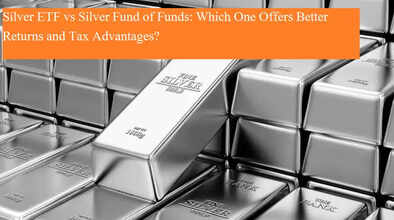Silver ETF vs Silver Fund of Funds: Which One Offers Better Returns and Tax Advantages?

Silver: The Emerging Investment Metal Beyond Gold
While gold continues to dominate the precious metals market, silver is increasingly catching the attention of investors—thanks to its dual role as both an investment asset and an industrial metal. In the past year, silver has delivered a 27% return, compared to gold’s 32%. Experts believe this is just the beginning, and silver could see a 15–20% surge in the near future.
Unlike gold, which is largely used for jewelry and investment, silver finds wide application in various industries such as solar energy, electronics, and electric vehicles. This industrial demand has been outpacing supply, which has resulted in a steady upward push in prices. In 2024, the global silver supply fell short compared to demand, further strengthening its price outlook.
Why Silver May Offer Higher Upside Potential
Experts point out that silver remains undervalued when compared to gold. This is evident from the gold-to-silver ratio, which historically averages around 68. Currently, the ratio is hovering around 90, suggesting silver is significantly cheaper relative to gold. If gold prices stabilize, silver could experience a 15% to 20% jump, according to market analysts.
Silver ETFs vs Silver FoFs: What’s the Difference?
For investors looking to tap into silver’s growth potential, two popular options exist: Silver Exchange Traded Funds (ETFs) and Silver Fund of Funds (FoFs). While both give exposure to silver, they differ in structure, cost, and accessibility.
-
Silver ETFs invest directly in physical silver. These units are traded on stock exchanges much like stocks. However, a Demat account is mandatory to invest in them.
-
Silver Fund of Funds (FoFs), on the other hand, invest in multiple silver ETFs. These can be purchased without a Demat account, making them more accessible for retail investors. The trade-off? A slightly higher expense ratio.
| Investment Type | Requires Demat | Expense Ratio (Approx.) |
|---|---|---|
| Silver ETF | Yes | 0.40% – 0.56% |
| Silver FoF | No | 0.70% – 0.96% |
Understanding the Tax Rules
The tax treatment of silver investments varies depending on the investment vehicle:
For Silver ETFs:
-
Long-term Capital Gains (LTCG): If held for more than 12 months, gains are taxed at 12.5%.
-
Short-term Capital Gains (STCG): Gains from units sold before 12 months are taxed as per the investor’s income tax slab.
For Silver FoFs:
-
LTCG: Applicable after 24 months of holding, taxed at 12.5%.
-
STCG: Gains from selling before 24 months are taxed according to the individual’s tax slab.
This makes Silver ETFs more tax-efficient for those looking to invest with a shorter horizon, provided they have a Demat account.
Final Thoughts: Which One Should You Choose?
If you already have a Demat account and are looking for lower expenses and slightly better tax efficiency, Silver ETFs are the better option. However, if convenience and accessibility are your priorities, and you’re comfortable with slightly higher costs, then Silver FoFs may suit you better.
With industrial demand on the rise and silver still undervalued relative to gold, both options offer solid avenues for diversification and long-term growth. Investors should assess their financial goals, tax bracket, and investment horizon before making a decision.

